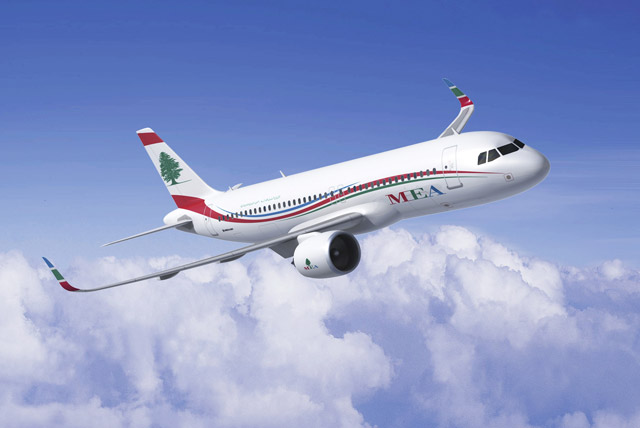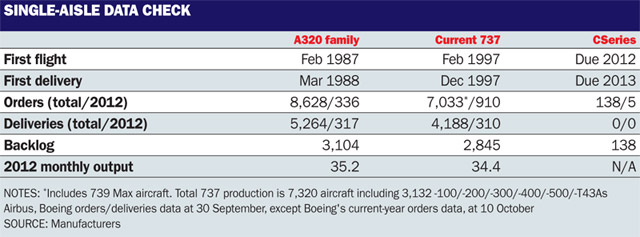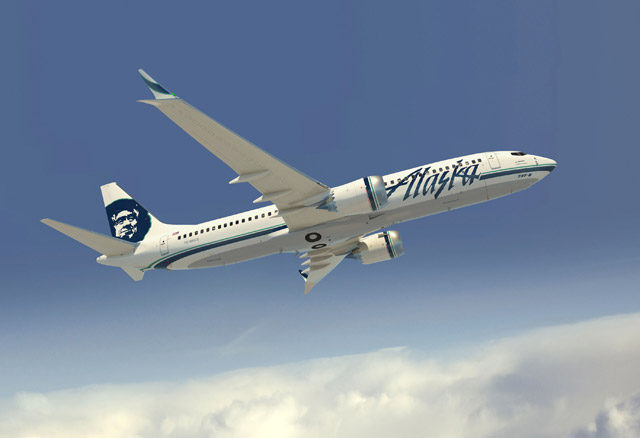Just as the Boeing 737 Max started moving this year from being a concept aircraft to a paper one, the rival Airbus A320neo began shifting from paper to metal.
Before the middle of the year Boeing's three-member Max family had been heavy on graphics - illustrating the size, shape and distinctive wing-tip design of the type - but light on performance data.
The Max's capabilities became clearer when Boeing revealed that the baseline 737-8 variant would raise the current 737-800's maximum take-off weight by 3,180kg (7,000lb) and extend its range by 540nm (1,000km).
 |
|---|
| Airbus Middle East Airlines has a preliminary deal with Airbus to purchase 10 A320neos |
This increase would take maximum take-off weight to just over 82t, compared with the 79t listed by Airbus for the A320neo, while the 3,620nm range will approach the A320neo's 3,700nm.
Solid Max numbers have inflamed the transatlantic battle of economic claim and counter-claim that had been a largely one-sided affair as Airbus pitted the A320neo against its own estimates of the Max's performance.
Airbus has started producing the first parts for the A320neo, focusing initially on the pylon that needs to support the larger CFM International Leap-1A or Pratt & Whitney PW1100G engines. The airframer is already turning out A320s with wing structures modified to accommodate the sharklet wing-tips that are undergoing flight testing.
It has insisted that the re-engined A320neo, which will have sharklets as standard, will restore a 15% advantage of fuel-burn per seat over the winglet-equipped 737-800 that the original A320 had over the 737-400.
While technological evolutions have left the current A320 and 737-800 evenly matched on fuel-burn per seat, the European airframer estimates that the A320neo - fitted with the CFM International Leap-1A - can achieve a 15% improvement through a 7% gain in the engine core, another 7% from the larger fan, and 1% from powerplant integration.
The sharklet wing-tips would provide another 2.4% although this would essentially serve to wipe out a 2.7% loss from the weight gain of 1.8t and higher drag.
Fan diameter has become central to the scrap over economics, with Airbus seizing on the limited ability of the Max to accommodate an increase in engine size.
COMPARISON SLIGHTS
Airbus argues that the Max could gain a 6% fuel-burn saving over the current 737 from core improvements on the corresponding Leap-1B engine, but crucially insists the restricted fan will add only 4%, with another 0.5% from integration benefits. Throwing in the penalty from drag, and heavier structural reworking, and Airbus estimates that the Max cuts the current 737 fuel-burn by 8%.
Airbus chief operating officer for customers John Leahy has suggested that Boeing would have to "heavily discount" to "make those numbers match". Boeing's latest list prices show a $7-13 million premium for the Max family compared with $8-10 million for the A320neo variants.
But Boeing has put up a robust defence, putting the A320neo's basic improvement on the A320 fuel burn per seat at just 12%, a result of higher weight and drag penalties detracting from a 14% saving through better engine technology.

It claims that the 737 Max will similarly gain 14% from the engine and another 2% from the split winglets and reshaped aft fuselage, losing 3% to weight and drag, to give an overall 13% gain in fuel-burn per seat on the 737-800. While this already exceeds Airbus's improvement on its baseline A320 airframe, Boeing believes - unlike its rival - that the starting positions are not equal, and that the 737-800 already has a 7% advantage, giving the Max a clear lead over the A320neo.
Boeing also dismisses the fan-size argument by pointing out that the 737 has a larger wing area but is structurally lighter than the A320, and therefore requires less thrust. It claims the A320neo "pays the economic price" for the thrust demands of the larger A321neo. Boeing will nevertheless maximise the powerplant gain by extending the 737 Max's nose-gear, allowing it to fit a 1.75m (5.74ft) diameter fan, at the expense of a blister fairing under the forward fuselage to house it.
Airbus is aiming to introduce the A320neo in the second half of 2015, while the Max will arrive in 2017.
While the A320neo's popularity was underscored during 2011, Boeing has piled on Max orders in response. Alaska Airlines opted for 37 of the type in October, taking the Max backlog to 858 and pushing Boeing's overall gross orders over the 1,000 mark for 2012.
Neither Boeing nor Airbus sees the Chinese-built Comac C919 - which has been gradually amassing commitments from Chinese customers - as posing a threat for at least a decade, although the twinjet has attracted attention from Western companies, among them International Airlines Group and Ryanair, prepared to take a closer look at the project.
 |
|---|
| Boeing Alaska Airlines opted for 37 of the type in October, taking the Max backlog to 858 |
Bombardier, in particular, has been cultivating a close relationship with the C919, exploring potential areas of technological co-operation with its own CSeries family.
The Canadian airframer remains something of a wild card as the CSeries approaches first flight. While Airbus, in particular, has pointed to the slow pace of orders for the type, the Canadian airframer is making steady progress, having completed the structural test fuselage in September, ahead of production of the first flight-test airframe.
Bombardier has also discussed the possibility of a higher-density, 160-seat version of its CS300, which would firmly pitch the type against the A319neo and the smallest 737 Max variant.
Low-cost carriers are among the target group for this version and AirAsia has been holding talks over a potential order for 100 of the type. The airframer has secured 138 orders for the CSeries among total commitments covering 352 aircraft.

Bombardier, which has been conducting extensive systems assessment - including virtual flights - on its Aircraft Zero test rig, had been intending to fly the Pratt & Whitney PW1500G-powered jet by the end of this year, but concedes that this could slip into early 2013 - tightening the window before service entry of the CS100, planned to take place in the same year.
For the flight-test programme Bombardier will build five aircraft but full CSeries production will take place in a new final assembly centre designed to construct 100 per year.
Source: Flight International























